Comparing the Dominant Factors in Coastal Morphology: Inappropriate Infrastructure vs. Climate Change—A Case Study of the Hsinchu Fishery Harbor, Taiwan
Abstract
:1. Introduction
2. Study Area
2.1. Description of the Study Area
2.2. Wave Climate
2.3. Hydrological Conditions
2.4. Typhoon Information in the Study Area
3. Data and Methods
3.1. Datasets
3.2. Definition of Typhoon and Climate Change Scenarios
3.3. Numerical Modeling
3.3.1. Two-Dimensional Hydrodynamic Model
3.3.2. Computational Domain and Grid
3.4. EOF Analysis
3.5. Methodological Approach
4. Results and Discussion
4.1. Model Calibration and Bathymetric Validation
4.2. Impact of Climate Change on Nearshore Wave Processes
4.3. Impact of Climate Change on Nearshore Morphological Processes
4.4. Impact of Climate Change on Anthropogenic Influences along the Hsinchu Coast
5. Conclusions
Author Contributions
Funding
Institutional Review Board Statement
Informed Consent Statement
Data Availability Statement
Acknowledgments
Conflicts of Interest
References
- IPCC. Contribution of Working Groups I, II and III to the Fifth Assessment Report of the Intergovernmental Panel on Climate Change; Synthesis Report; IPCC: Geneva, Switzerland, 2014. [Google Scholar]
- Ekström, M.; Grose, M.; Whetton, P.V. An appraisal of downscaling methods used in climate change research. WIREs Climate Change 2015, 6, 301–319. [Google Scholar] [CrossRef]
- Huang, W.-P.; Hsu, J.-C.; Ye, C.-J. Assessing the impact factors and corresponding weights affecting the coastal morphology of Hsinchu Coast, Taiwan. J. Sea Res. 2023, 195, 102432. [Google Scholar] [CrossRef]
- Gao, A.; Yang, S.L.; Li, G.; Li, P.; Chen, S.L. Long-term morphological evolution of a tidal island as affected by natural factors and human activities, the Yangtze estuary. J. Coast. Res. 2010, 26, 123–131. [Google Scholar] [CrossRef]
- Jordan, C.; Visscher, J.; Viet Dung, N.; Apel, H.; Schlurmann, T. Impacts of Human Activity and Global Changes on Future Morphodynamics within the Tien River, Vietnamese Mekong Delta. Water 2020, 12, 2204. [Google Scholar] [CrossRef]
- Robins, P.E.; Skov, M.W.; Lewis, M.J.; Giménez, L.; Davies, A.G.; Malham, S.K.; Neill, S.P.; McDonald, J.E.; Whitton, T.A.; Jack-son, S.E.; et al. Impact of climate change on UK estuaries: A review of past trends and potential projections. Estuar. Coast. Shelf Sci. 2016, 169, 119–135. [Google Scholar] [CrossRef]
- Lin, L.-Y.; Lin, C.-T.; Chen, Y.-M.; Cheng, C.-T.; Li, H.-C.; Chen, W.-B. The Taiwan Climate Change Projection Information and Adaptation Knowledge Platform: A Decade of Climate Research. Water 2022, 14, 358. [Google Scholar] [CrossRef]
- Ministry of the Interior. The Integrated Coastal Zone Management Plan—The First Overall Review; Ministry of the Interior: Taipei, Taiwan, 2021. [Google Scholar]
- Trenberth, K.E. Changes in precipitation with climate change. Clim. Res. 2011, 47, 123–138. [Google Scholar] [CrossRef]
- Dunn, F.E.; Darby, S.E.; Nicholls, R.J.; Cohen, S.; Zarfl, C.; Fekete, B.M. Projections of declining fluvial sediment delivery to major deltas worldwide in response to climate change and anthropogenic stress. Environ. Res. Lett. 2019, 14, 084034. [Google Scholar] [CrossRef]
- Wild, A.L.; Kwoll, E.; Lintern, D.G.; Fargey, S. Fluvial Response to Climate Change in the Pacific Northwest: Skeena River Discharge and Sediment Yield. Water 2023, 15, 167. [Google Scholar] [CrossRef]
- Rohini, S.; Sannasiraj, S.A.; Sundar, V. Investigation on influence of RCP-based climate scenarios on the hydrodynamic and morphodynamic changes during extreme events. Appl. Ocean Res. 2023, 138, 103660. [Google Scholar] [CrossRef]
- Holden, W.N.; Marshall, S.J. Chapter 24—Climate Change and Typhoons in the Philippines: Extreme Weather Events in the Anthropocene. In Integrating Disaster Science and Management; Samui, P., Kim, D., Ghosh, C., Eds.; Elsevier: Amsterdam, The Netherlands, 2018; pp. 407–421. [Google Scholar]
- Marsooli, R.; Jamous, M.; Miller, J.K. Climate change impacts on wind waves generated by major tropical cyclones off the coast of New Jersey, USA. Front. Built Environ. 2021, 7, 774084. [Google Scholar] [CrossRef]
- Ku, H.; Maeng, J.H.; Cho, K. Climate change impact on typhoon-induced surges and wind field in coastal region of South Korea. J. Wind Eng. Ind. Aerodyn. 2019, 190, 112–118. [Google Scholar] [CrossRef]
- Rao, A.D.; Upadhaya, P.; Pandey, S.; Poulose, J. Simulation of extreme water levels in response to tropical cyclones along the Indian coast: A climate change perspective. Nat. Hazards 2020, 100, 151–172. [Google Scholar] [CrossRef]
- Chang, C.-H.; Shih, H.-J.; Chen, W.-B.; Su, W.-R.; Lin, L.-Y.; Yu, Y.-C.; Jang, J.-H. Hazard Assessment of Typhoon-Driven Storm Waves in the Nearshore Waters of Taiwan. Water 2018, 10, 926. [Google Scholar] [CrossRef]
- Warren, I.R.; Bach, H.K. MIKE 21: A modelling system for estuaries, coastal waters and seas. Environ. Softw. 1992, 7, 229–240. [Google Scholar] [CrossRef]
- Anton, I.A.; Rusu, L.; Anton, C. Nearshore Wave Dynamics at Mangalia Beach Simulated by Spectral Models. J. Mar. Sci. Eng. 2019, 7, 206. [Google Scholar] [CrossRef]
- Parvathy, K.G.; Gopinath, D.I.; Noujas, V.; Thomas, K.V. Wave Transformation along Southwest coast of India using MIKE 21. Int. J. Ocean Clim. Syst. 2014, 5, 23–34. [Google Scholar] [CrossRef]
- Nguyen, V.T.; Vu, M.T.; Zhang, C. Numerical investigation of hydrodynamics and cohesive sediment transport in Cua Lo and Cua Hoi Estuaries, Vietnam. J. Mar. Sci. Eng. 2021, 9, 1258. [Google Scholar] [CrossRef]
- Huang, W.-P. Modelling the effects of typhoons on morphological changes in the Estuary of Beinan, Taiwan. Cont. Shelf Res. 2017, 135, 1–13. [Google Scholar] [CrossRef]
- Huang, W.-P. Impact of coastal development on coastal morphology of Taiwan: Case studies and proposed countermeasures. J. Sea Res. 2022, 186, 102234. [Google Scholar] [CrossRef]
- Ghaderi, D.; Rahbani, M. Simultaneous employment of hydrodynamical simulation and RS imageries for analyzing the influence of an anthropogenic construction on shoreline transformation. J. Hydraul. Struct. 2023, 9, 14–31. [Google Scholar] [CrossRef]
- Irmawan, M.; Alam, R.R.R.; Refani, A.N.; Aini, A.N. Hydrodynamic Analysis-Based Modeling of Coastal Abrasion Prevention (Case Study: Pulau Baai Port, Bengkulu). Appl. Sci. 2024, 14, 940. [Google Scholar] [CrossRef]
- Tuan, V.M.; Thanh, N.V.; Lai, T.D. Accessing impacts of climate change-driven sea level rise on hydrodynamics and sediment dynamics along Ba Lang beaches in Nha Trang Bay, Khanh Hoa, Vietnam. Water Sci. Eng. 2023; in press. [Google Scholar] [CrossRef]
- Dastgheib, A.; Reyns, J.; Thammasittirong, S.; Weesakul, S.; Thatcher, M.; Ranasinghe, R. Variations in the Wave Climate and Sediment Transport Due to Climate Change along the Coast of Vietnam. J. Mar. Sci. Eng. 2016, 4, 86. [Google Scholar] [CrossRef]
- Winant, C.D.; Inman, D.L.; Nordstrom, C.E. Description of seasonal beach changes using empirical eigenfunctions. J. Geophys. Res. 1975, 80, 1979–1986. [Google Scholar] [CrossRef]
- Miller, J.K.; Dean, R.G. Shoreline variability via empirical orthogonal function analysis: Part I temporal and spatial characteristics. Coast. Eng. 2007, 54, 111–131. [Google Scholar] [CrossRef]
- Miller, J.K.; Dean, R.G. Shoreline variability via empirical orthogonal function analysis: Part II relationship to nearshore conditions. Coast. Eng. 2007, 54, 133–150. [Google Scholar] [CrossRef]
- Taaouati, M.; Parisi, P.; Passoni, G.; Lopez-Garcia, P.; Romero-Cozar, J.; Anfuso, G.; Vidal, J.; Muñoz-Perez, J.J. Influence of a Reef Flat on Beach Profiles Along the Atlantic Coast of Morocco. Water 2020, 12, 790. [Google Scholar] [CrossRef]
- Hu, Y.; Cao, M.; Ma, A.; Dou, X.; Wen, Y. An Analysis of the Periodic Evolution of the Jingjiang Sandbank in the Tidal Reach of the Yangtze River. Water 2020, 12, 1652. [Google Scholar] [CrossRef]
- Afentoulis, V.; Papadimitriou, A.; Belibassakis, K.; Tsoukala, V. A coupled model for sediment transport dynamics and prediction of seabed morphology with application to 1DH/2DH coastal engineering problems. Oceanologia 2022, 64, 514–534. [Google Scholar] [CrossRef]
- Mercier, P.; Thiébaut, M.; Guillou, S.; Maisondieu, C.; Poizot, E.; Pieterse, A.; Thiébot, J.; Filipot, J.-F.; Grondeau, M. Turbulence measurements: An assessment of Acoustic Doppler Current Profiler accuracy in rough environment. Ocean Eng. 2021, 226, 108819. [Google Scholar] [CrossRef]
- Belibassakis, K.A.; Karathanasi, F.E. Modelling nearshore hydrodynamics and circulation under the impact of high waves at the coast of Varkiza in Saronic—Athens Gulf. Oceanologia 2017, 59, 350–364. [Google Scholar] [CrossRef]
- DHI. MIKE 21 and MIKE 3 Flow Model FM Hydrodynamic and Transport Module Scientific Documentation; DHI Water and Environment: Hørsholm, Denmark, 2012. [Google Scholar]
- Reeve, D.E.; Horrillo-Caraballo, J.M.; Magar, V. Statistical analysis and forecasts of long-term sandbank evolution at Great Yarmouth, UK. Estuar. Coast. Shelf Sci. 2008, 79, 387–399. [Google Scholar] [CrossRef]
- Wang, X.; Zhang, W.; Tong, C.; Huang, R. Unraveling the control factors of long-term morphological evolution in the Yangtze Estuary: A synthesis of natural processes and human interventions. Estuar. Coast. Shelf Sci. 2024, 304, 108842. [Google Scholar] [CrossRef]
- Keshtpoor, M.; Puleo, J.A.; Gebert, J.; Plant, N.G. Beach response to a fixed sand bypassing system. Coast. Eng. 2013, 73, 28–42. [Google Scholar] [CrossRef]
- Ray, R.D.; Foster, G. Future nuisance flooding at Boston caused by astronomical tides alone. Earth’s Future 2016, 4, 578–587. [Google Scholar] [CrossRef]
- Melo, W.; Pinho, J.; Iglesias, I.; Bio, A.; Avilez-Valente, P.; Vieira, J.; Bastos, L.; Veloso-Gomes, F. Hydro- and Morphodynamic Impacts of Sea Level Rise: The Minho Estuary Case Study. J. Mar. Sci. Eng. 2020, 8, 441. [Google Scholar] [CrossRef]
- Rameshwaran, P.; Bell, V.A.; Davies, H.N.; Kay, A.L. How might climate change affect river flows across West Africa? Clim. Chang. 2021, 169, 21. [Google Scholar] [CrossRef]
- Rodríguez-Blanco, M.L.; Arias, R.; Taboada-Castro, M.M.; Nunes, J.P.; Keizer, J.J.; Taboada-Castro, M.T. Potential Impact of Climate Change on Suspended Sediment Yield in NW Spain: A Case Study on the Corbeira Catchment. Water 2016, 8, 444. [Google Scholar] [CrossRef]
- Cox, J.R.; Dunn, F.; Nienhuis, J.; van der Perk, M.; Kleinhans, M. Climate change and human influences on sediment fluxes and the sediment budget of an urban delta: The example of the lower Rhine-Meuse Delta distributary network. Anthr. Coasts 2021, 4, 251–280. [Google Scholar] [CrossRef]
- Zarifsanayei, A.R.; Etemad-Shahidi, A.; Cartwright, N.; Strauss, D. Long-term prediction of longshore sediment transport in the context of climate change. Coast. Eng. Proc. 2020, 36, 15. [Google Scholar] [CrossRef]
- Hirschberg, J.; Fatichi, S.; Bennett, G.L.; McArdell, B.W.; Peleg, N.; Lane, S.N.; Schlunegger, F.; Molnar, P. Climate change impacts on sediment yield and debrisflow activity in an Alpine catchment. J. Geophys. Res. Earth Surf. 2021, 126, e2020JF005739. [Google Scholar] [CrossRef]
Disclaimer/Publisher’s Note: The statements, opinions, and data contained in all publications are solely those of the individual author(s) and contributor(s) and not of MDPI and/or the editor(s). MDPI and/or the editor(s) disclaim responsibility for any injury to people or property resulting from any ideas, methods, instructions, or products referred to in the content. |
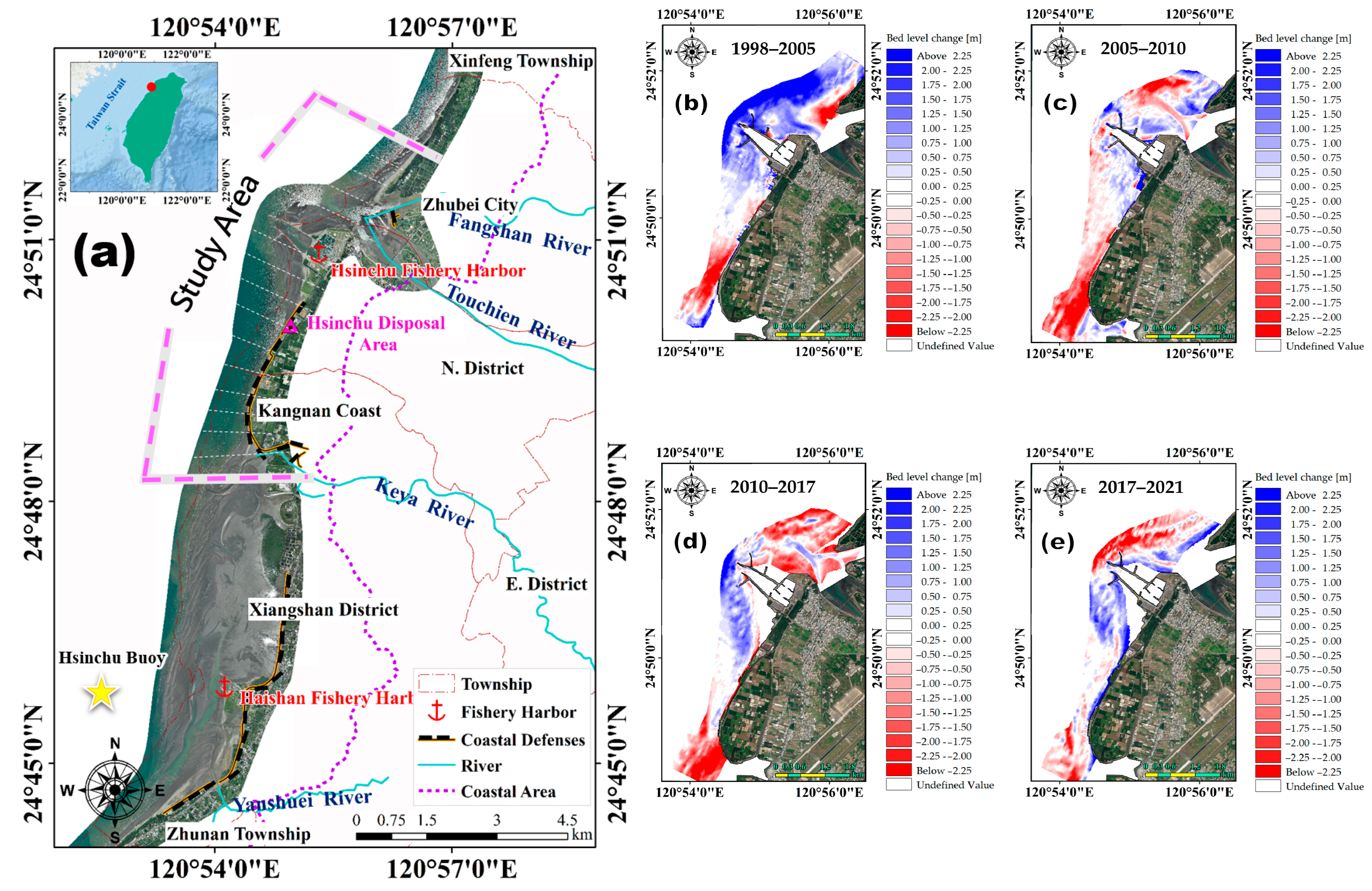


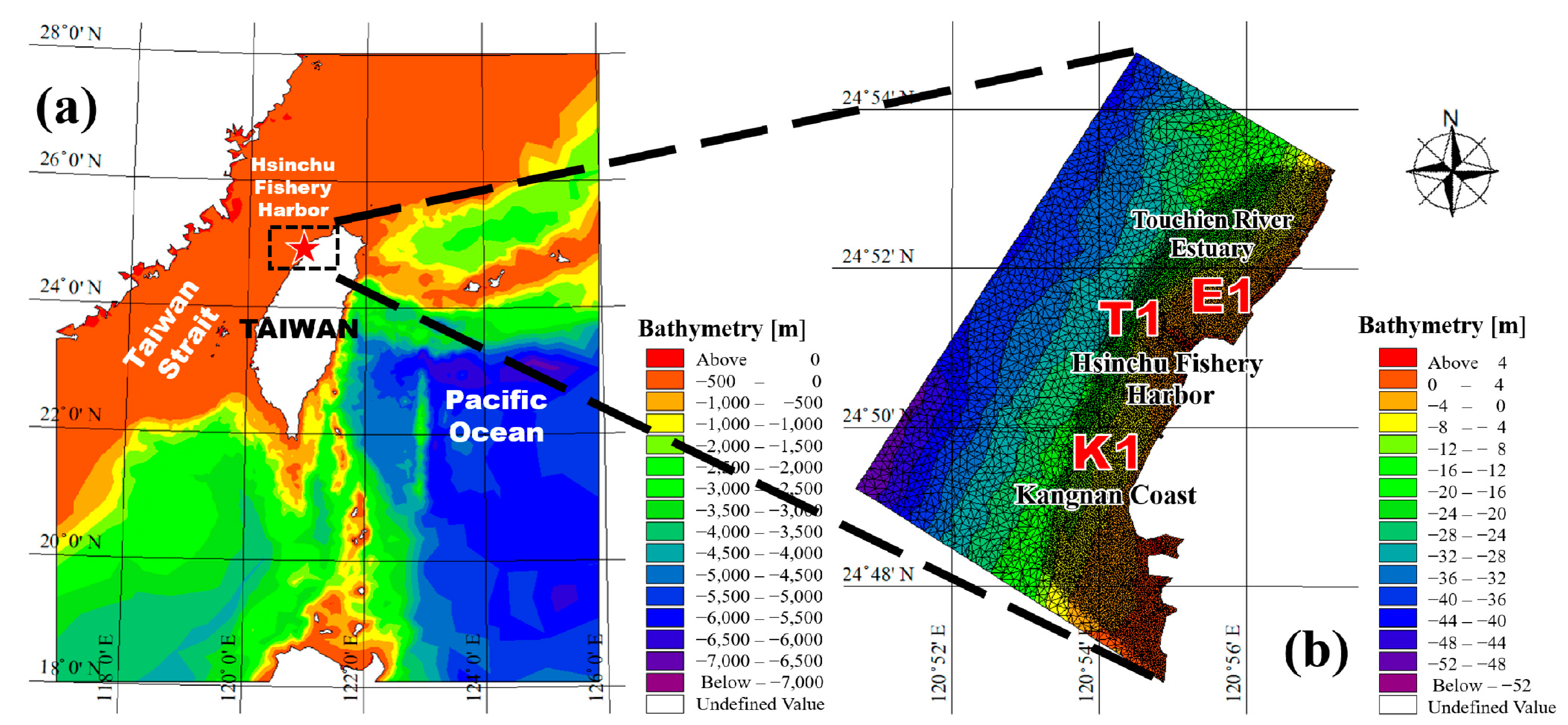
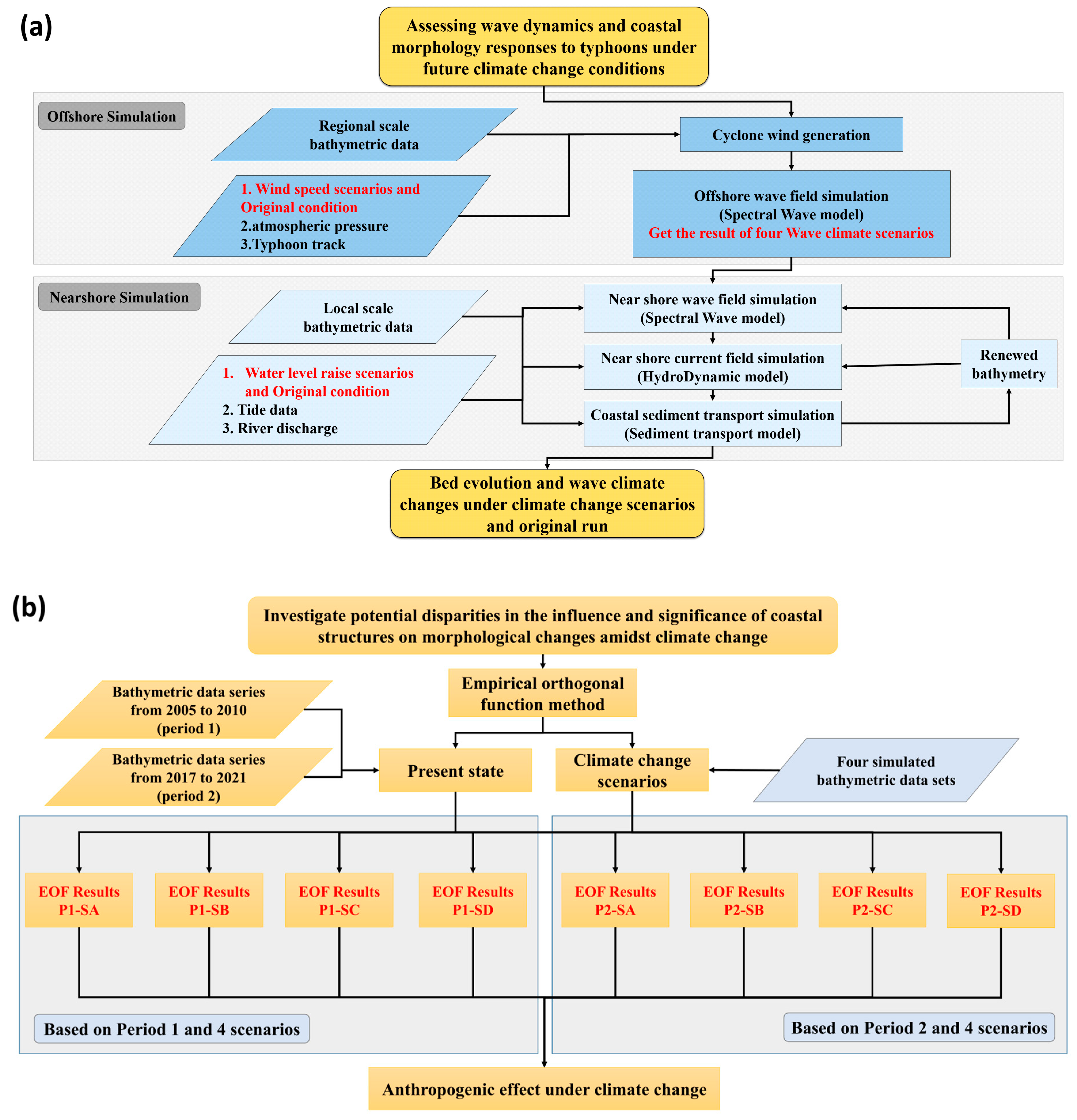
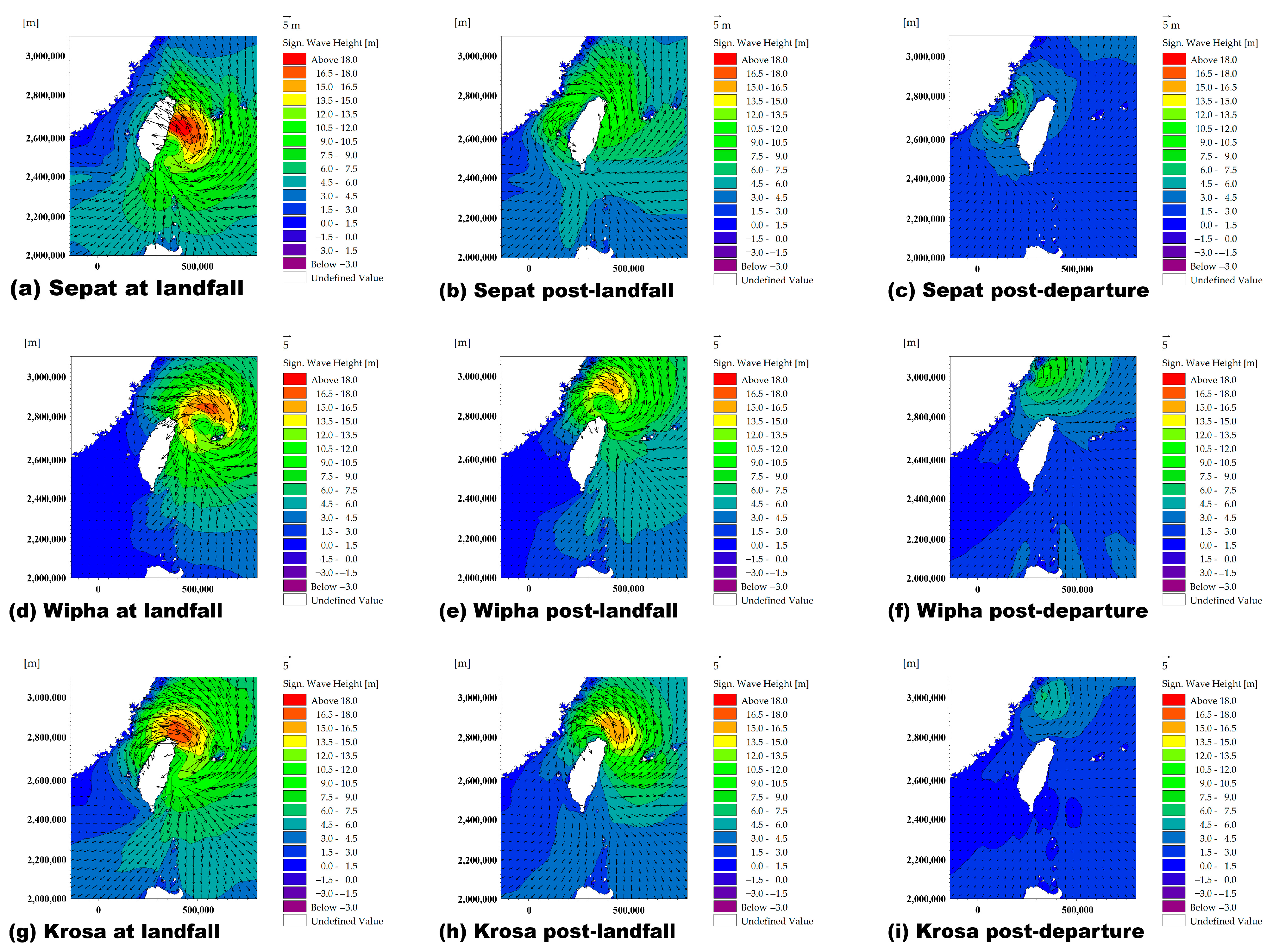
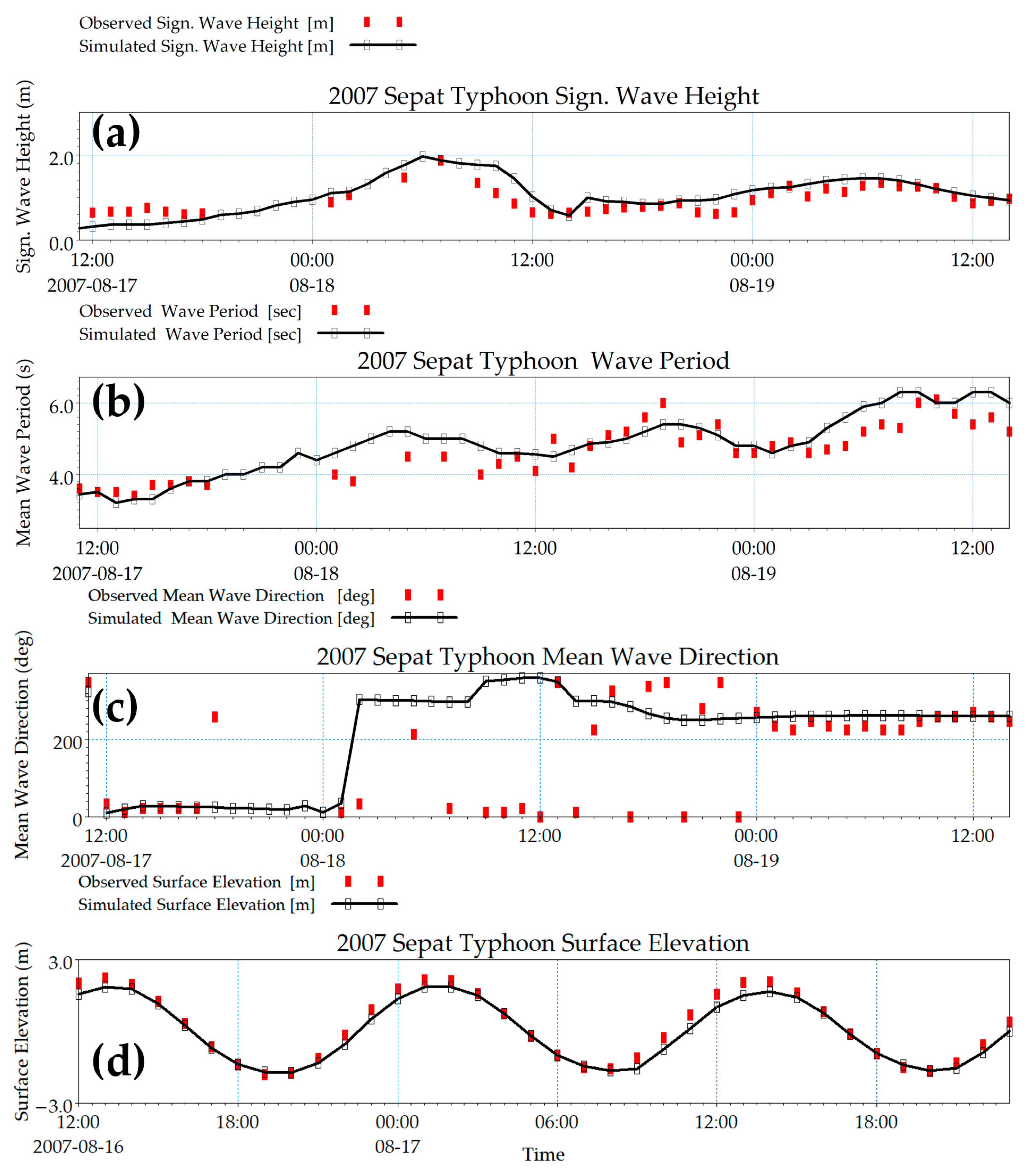
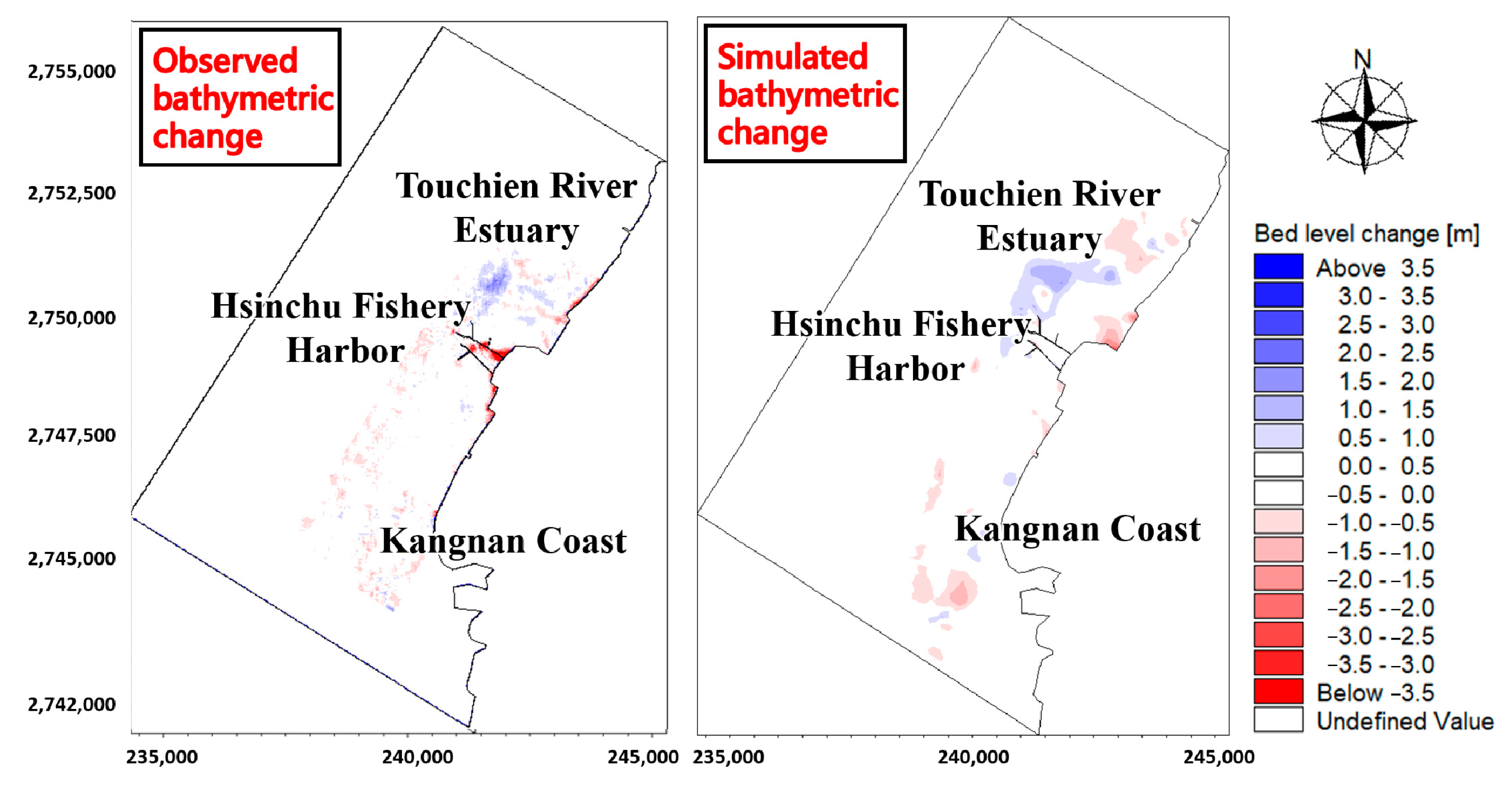
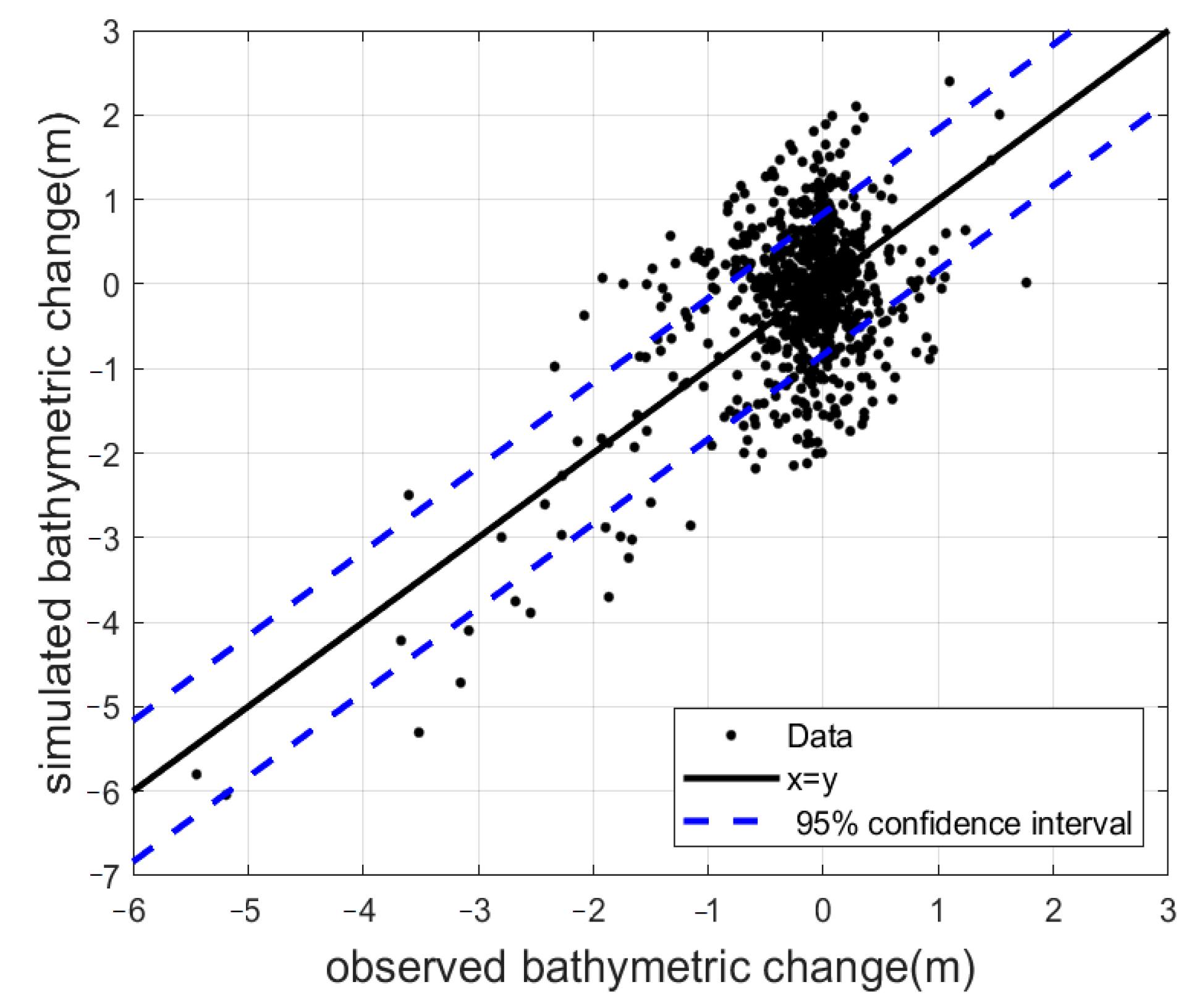
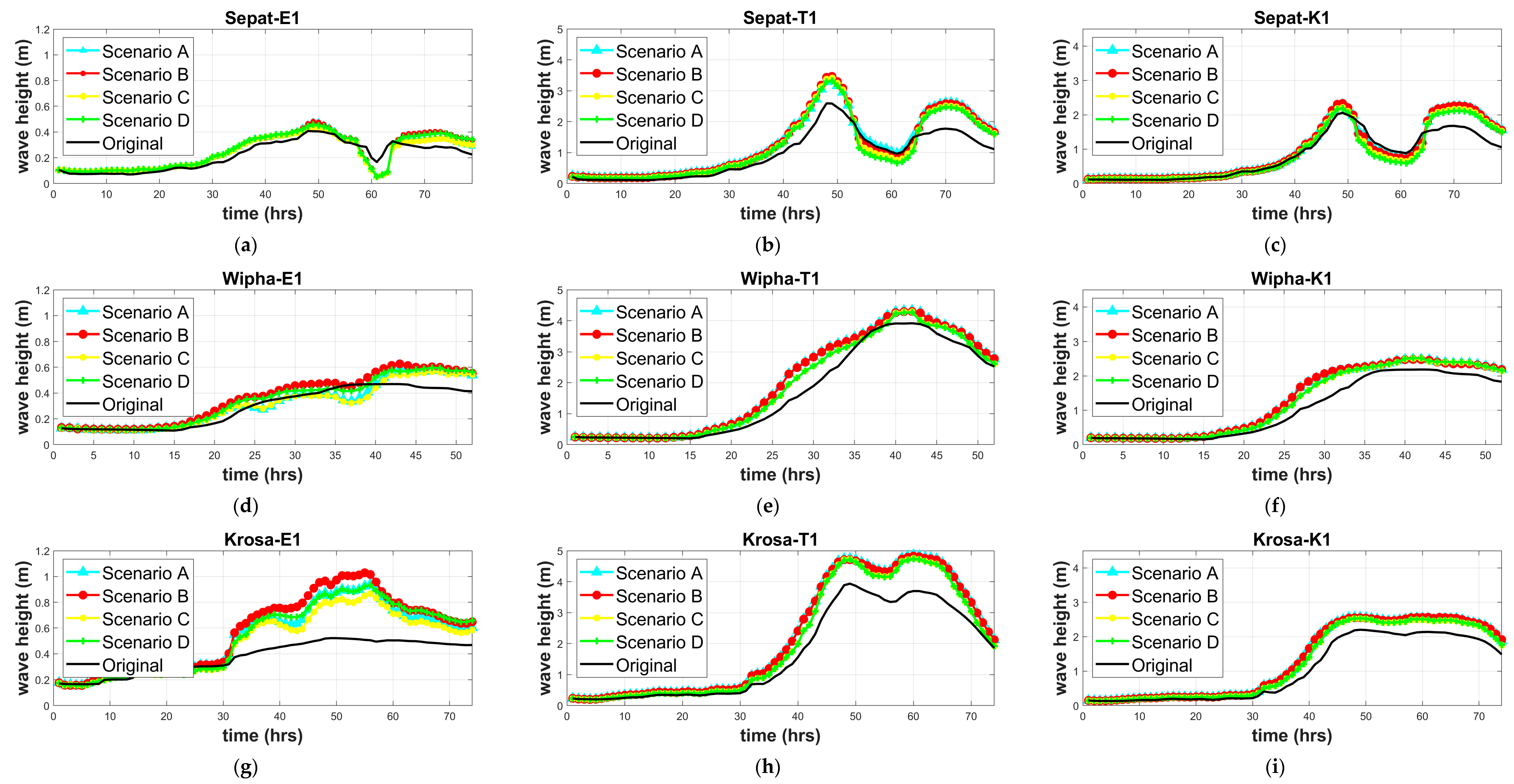
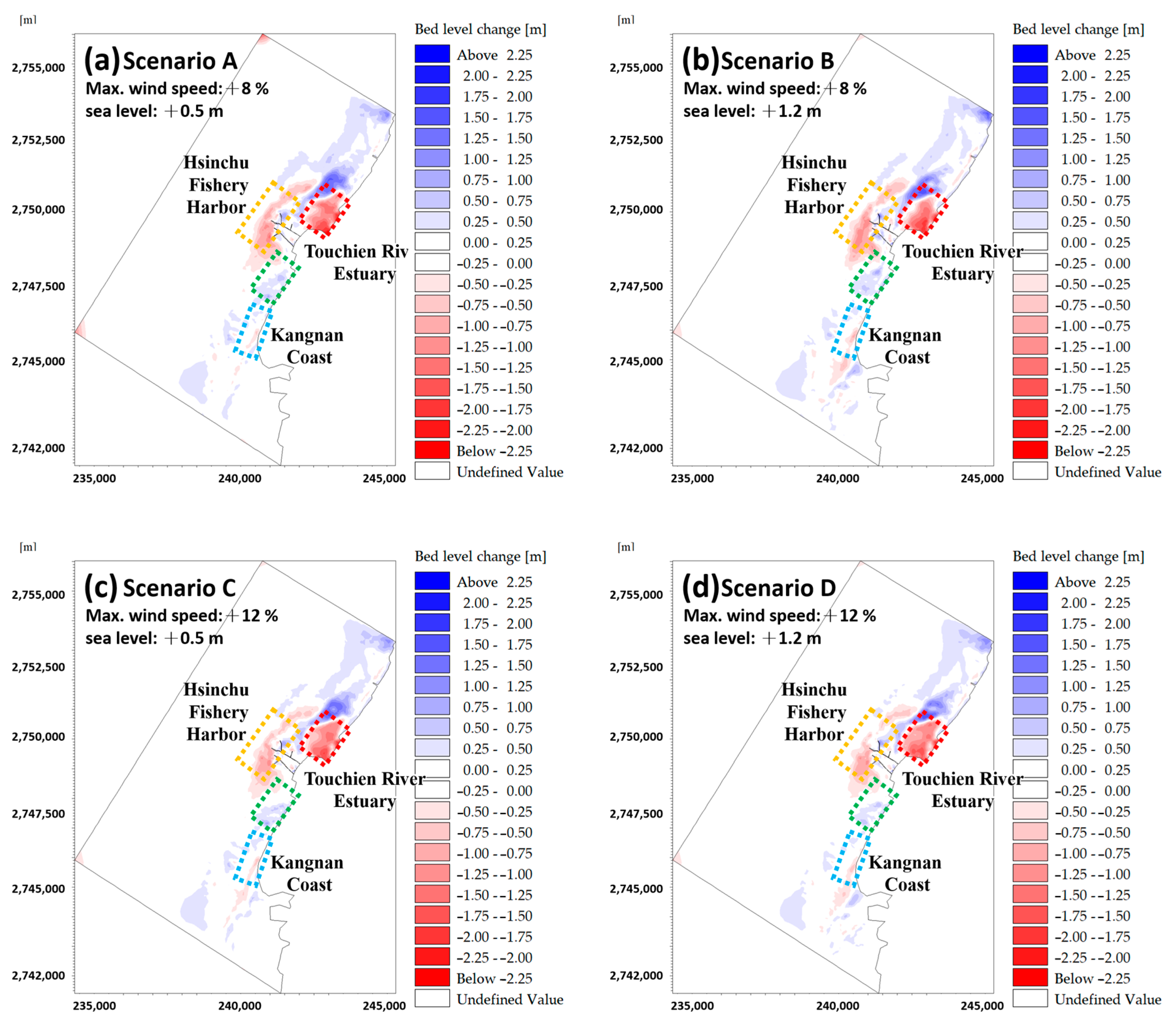

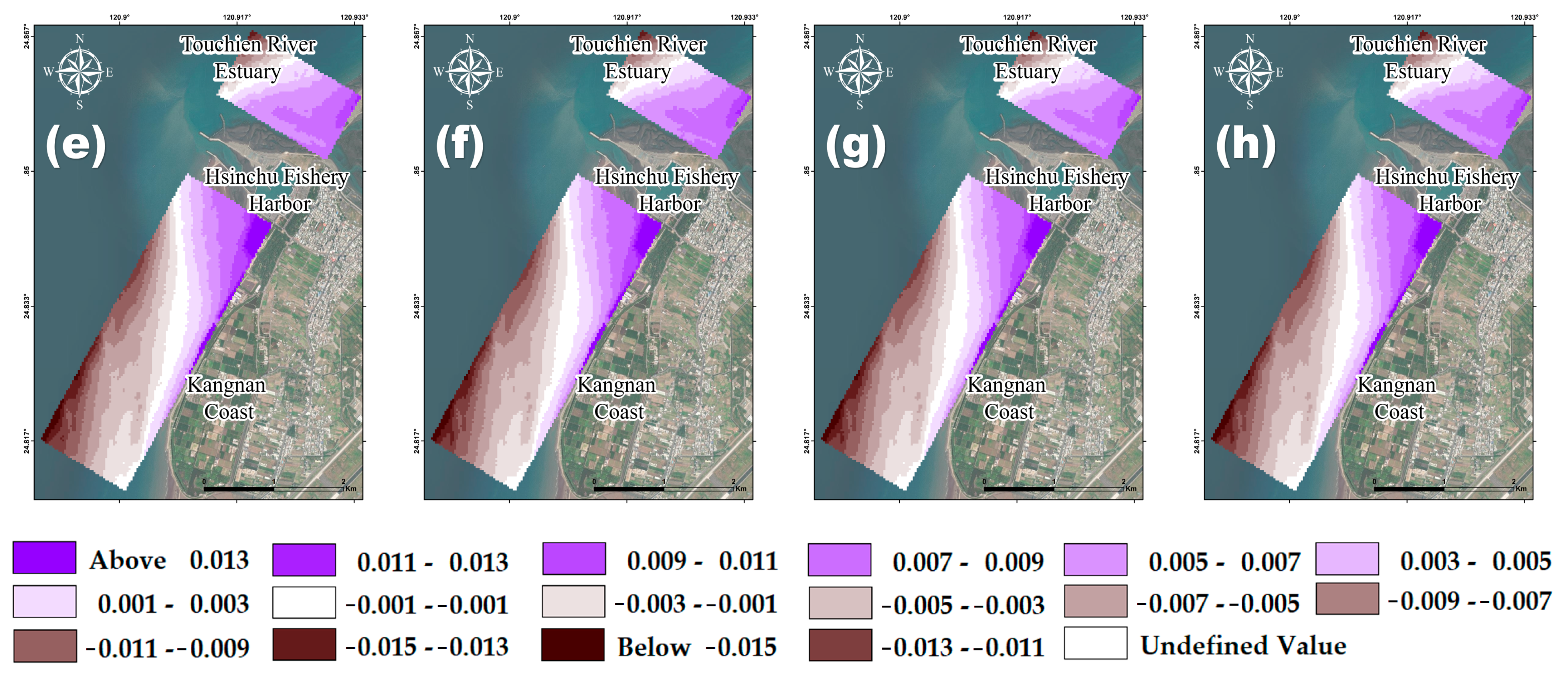
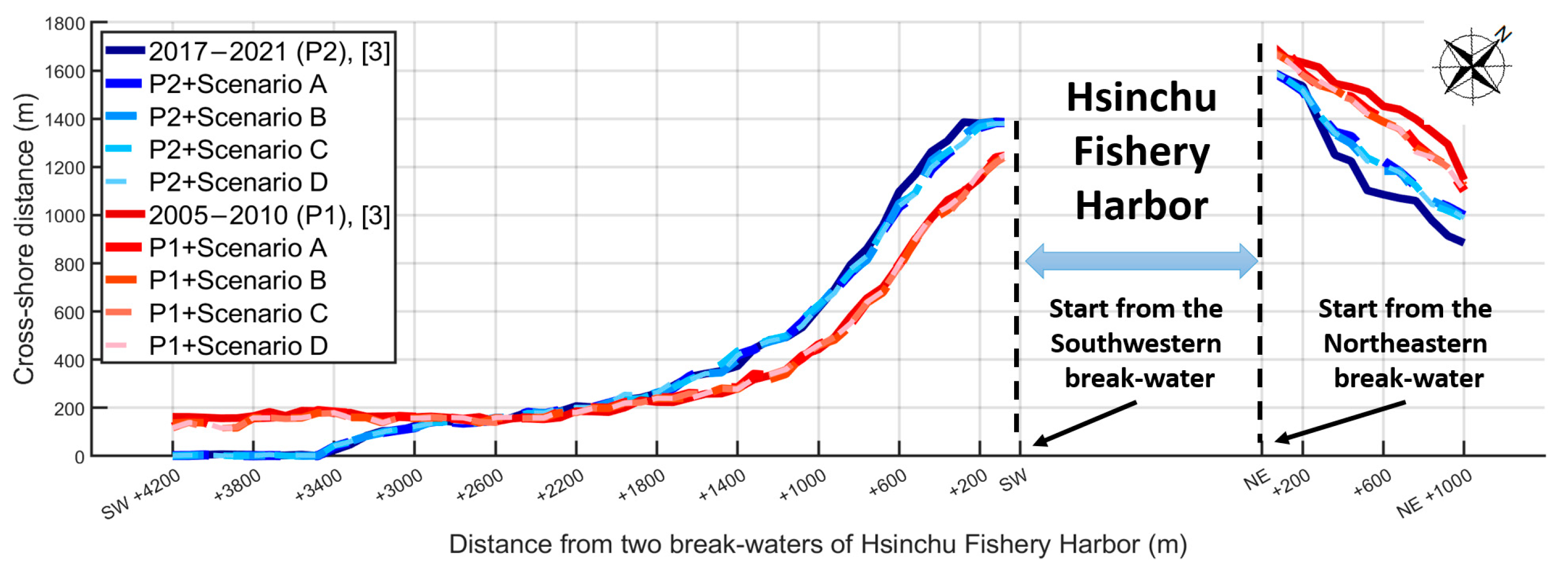
| Year | No. | Typhoon Name | Track CAT. | Typhoon Intensity | Year | No. | Typhoon Name | Track CAT. | Typhoon Intensity |
|---|---|---|---|---|---|---|---|---|---|
| 1994 | 01 | GLADYS | 2 | Moderate | 2009 | 01 | MORAKOT | 3 | Moderate |
| 02 | FRED | 1 | Severe | ||||||
| 03 | CAITLIN | 3 | Mild | ||||||
| 04 | TIM | 3 | Severe | ||||||
| 1995 | - | - | - | - | 2010 | - | - | - | - |
| 1996 | 05 | HERB | 1 | Severe | 2011 | - | - | - | - |
| 1997 | 06 | AMBER | 3 | Moderate | 2012 | 02 | SAOLA | 2 | Moderate |
| WINNIE | 1 | Moderate | |||||||
| 1998 | 07 | OTTO | 3 | Mild | 2013 | 03 | FITOW | 1 | Moderate |
| 04 | TRAMI | 1 | Mild | ||||||
| 05 | SOULIK | 2 | Severe | ||||||
| 1999 | - | - | - | - | 2014 | 06 | MATMO | 3 | Moderate |
| 2000 | 08 | BILIS | 3 | Severe | 2015 | 07 | DUJUAN | 2 | Severe |
| 08 | SOUDELOR | 3 | Moderate | ||||||
| 2001 | 09 | TORAJI | 3 | Moderate | 2016 | 09 | MEGI | 3 | Moderate |
| 2002 | 10 | SINLAKU | 1 | Moderate | 2017 | 10 | NESAT | 2 | Moderate |
| 2003 | - | - | - | - | 2018 | 11 | MARIA | 1 | Severe |
| 2004 | 11 | AERE | 1 | Moderate | 2019 | 12 | LEKIMA | 1 | Severe |
| 2005 | 12 | LONGWANG | 3 | Severe | 2020 | - | - | - | - |
| 13 | TALIM | 3 | Severe | ||||||
| 14 | MATSA | 1 | Moderate | ||||||
| 15 | HAITANG | 3 | Severe | ||||||
| 2006 | 16 | KAEMI | 3 | Moderate Mild | 2021 | - | - | - | - |
| 17 | BILIS | 2 | |||||||
| 2007 | 18 | WUTIP | 3 | Mild | 2022 | - | - | - | - |
| 19 | SEPAT | 3 | Severe | ||||||
| 20 | WIPHA | 1 | Moderate | ||||||
| 21 | KROSA | 2 | Severe | ||||||
| 2008 | 22 | JANGMI | 2 | Severe | 2023 | - | - | - | - |
| 23 | SINLAKU | 2 | Severe | ||||||
| 24 | FUNG-WONG | 3 | Moderate | ||||||
| 25 | KALMAEGI | 2 | Moderate |
| Case | Scenario A | Scenario B | Scenario C | Scenario D |
|---|---|---|---|---|
| Wind speed increase (%) | 8% | 8% | 12% | 12% |
| Extreme sea levels (ESL) | +0.5 m | +1.2 m | +0.5 m | +1.2 m |
| Sepat Typhoon (Track No. 3) | Wipha Typhoon (Track No. 1) | Krosa Typhoon (Track No. 2) | |||||||||
|---|---|---|---|---|---|---|---|---|---|---|---|
| Position | E1 | T1 | K1 | Position | E1 | T1 | K1 | Position | E1 | T1 | K1 |
| Max. in S1 | 0.48 m | 3.30 m | 2.18 m | Max. in S1 | 0.59 m | 4.33 m | 2.48 m | Max. in S1 | 0.94 m | 4.86 m | 2.56 m |
| Max. in S2 | 0.48 m | 3.30 m | 2.20 m | Max. in S2 | 0.63 m | 4.30 m | 2.40 m | Max. in S2 | 1.03 m | 4.83 m | 2.56 m |
| Max. in S3 | 0.44 m | 3.35 m | 2.17 m | Max. in S3 | 0.57 m | 4.30 m | 2.50 m | Max. in S3 | 0.87 m | 4.75 m | 2.53 m |
| Max. in S4 | 0.46 m | 3.33 m | 2.18 m | Max. in S4 | 0.60 m | 4.27 m | 2.52 m | Max. in S4 | 0.93 m | 4.74 m | 2.53 m |
| Max. in control run | 0.40 m | 2.59 m | 2.06 m | Max. control run | 0.47 m | 3.92 m | 2.19 | Max. control run | 0.47 m | 3.94 m | 2.20 m |
| Std. in S1 | 1.20 | 1.27 | 1.06 | Std. in S1 | 1.26 | 1.10 | 1.13 | Std. in S1 | 1.81 | 1.23 | 1.16 |
| Std. in S2 | 1.20 | 1.27 | 1.07 | Std. in S2 | 1.34 | 1.10 | 1.10 | Std. in S2 | 1.98 | 1.23 | 1.16 |
| Std. in S3 | 1.10 | 1.29 | 1.05 | Std. in S3 | 1.21 | 1.10 | 1.14 | Std. in S3 | 1.67 | 1.21 | 1.15 |
| Std. in S4 | 1.20 | 1.29 | 1.06 | Std. in S4 | 1.28 | 1.09 | 1.15 | Std. in S4 | 1.79 | 1.20 | 1.15 |
| Percentage change in S1 | 20.0% | 27.41% | 5.83% | Percentage change in S1 | 25.53% | 10.46% | 12.24% | Percentage change in S1 | 80.76% | 23.35% | 16.36% |
| Percentage change in S2 | 20.0% | 27.41% | 6.80% | Percentage change in S2 | 34.04% | 9.70% | 9.59% | Percentage change in S2 | 98.08% | 22.59% | 16.36% |
| Percentage change in S3 | 10.0% | 29.43% | 5.34% | Percentage change in S3 | 21.28% | 9.70% | 14.16% | Percentage change in S3 | 67.30% | 20.56% | 15.00% |
| Percentage change in S4 | 14.50% | 28.57% | 5.83% | Percentage change in S4 | 27.66% | 8.93% | 15.07% | Percentage change in S4 | 78.85% | 20.30% | 15.00% |
| Avg. S1 to S4 | 16.12% | 28.18% | 5.94% | Avg. S1 to S4 | 27.13% | 9.69% | 13.01% | Avg. S1 to S4 | 81.25% | 21.70% | 15.68% |
| Huang [3] Mode-1 | With Scenario A | With Scenario B | With Scenario C | With Scenario D | |
|---|---|---|---|---|---|
| EOF Model-1 from 2005 to 2010 | 93.61% | 95.08% | 94.08% | 94.98% | 94.91% |
| Comparison of results from Huang [3] | n/a | 1.57% | 0.50% | 1.46% | 1.39% |
| EOF Model-1 from 2017 to 2021 | 98.29% | 96.17% | 96.76% | 96.22% | 96.30% |
| Comparison of results from Huang [3] | n/a | −2.16% | −1.56% | −2.11% | −2.02% |
Disclaimer/Publisher’s Note: The statements, opinions and data contained in all publications are solely those of the individual author(s) and contributor(s) and not of MDPI and/or the editor(s). MDPI and/or the editor(s) disclaim responsibility for any injury to people or property resulting from any ideas, methods, instructions or products referred to in the content. |
© 2024 by the authors. Licensee MDPI, Basel, Switzerland. This article is an open access article distributed under the terms and conditions of the Creative Commons Attribution (CC BY) license (https://creativecommons.org/licenses/by/4.0/).
Share and Cite
Hsu, J.-C.; Huang, W.-P.; Ye, C.-J. Comparing the Dominant Factors in Coastal Morphology: Inappropriate Infrastructure vs. Climate Change—A Case Study of the Hsinchu Fishery Harbor, Taiwan. Sustainability 2024, 16, 5563. https://doi.org/10.3390/su16135563
Hsu J-C, Huang W-P, Ye C-J. Comparing the Dominant Factors in Coastal Morphology: Inappropriate Infrastructure vs. Climate Change—A Case Study of the Hsinchu Fishery Harbor, Taiwan. Sustainability. 2024; 16(13):5563. https://doi.org/10.3390/su16135563
Chicago/Turabian StyleHsu, Jui-Chan, Wei-Po Huang, and Chun-Jhen Ye. 2024. "Comparing the Dominant Factors in Coastal Morphology: Inappropriate Infrastructure vs. Climate Change—A Case Study of the Hsinchu Fishery Harbor, Taiwan" Sustainability 16, no. 13: 5563. https://doi.org/10.3390/su16135563





